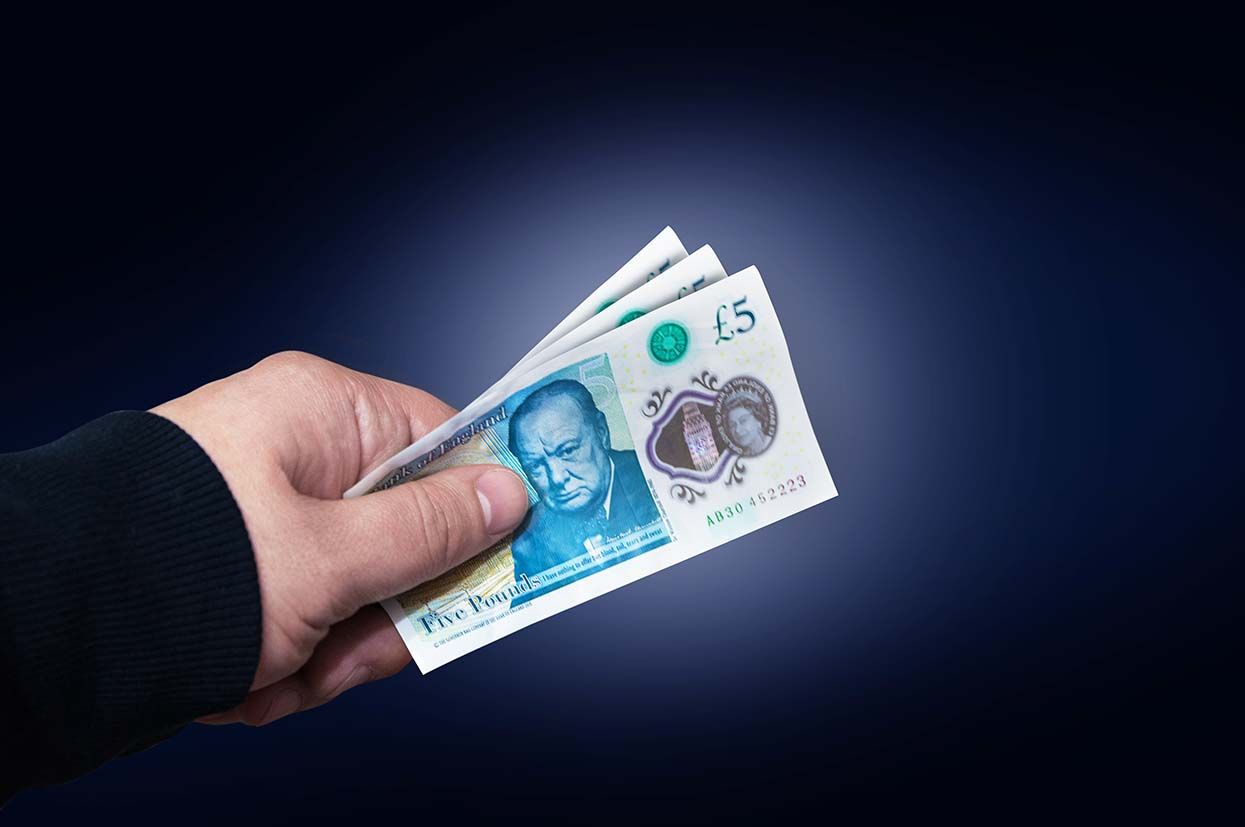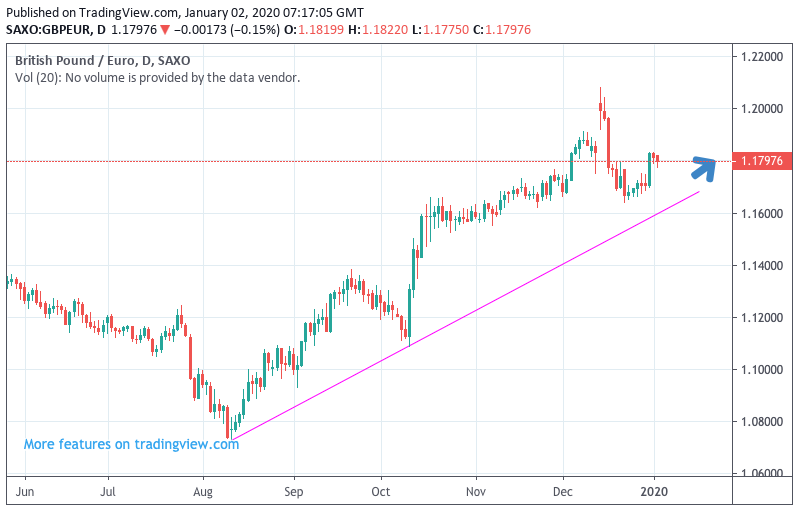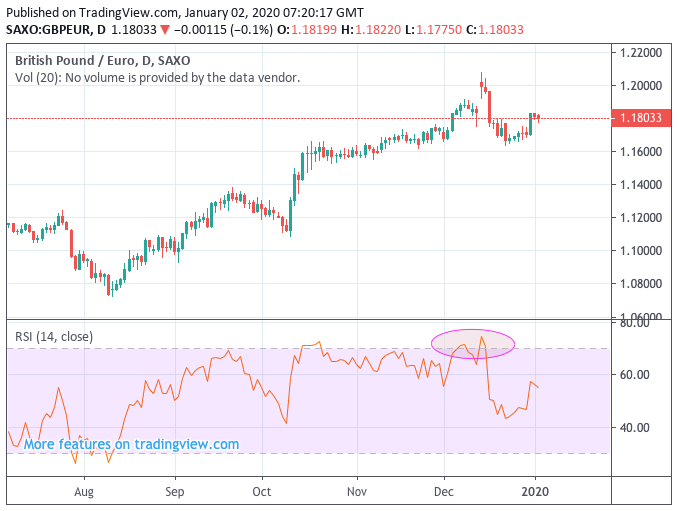Pound-Euro Exchange Rate Uptrend Intact, 1.20 Remains Viable Target

Image © Adobe Images
- Pound retains positive bias against Euro
- Recent pullback technical in nature
- Records a 5% advance in 2019
- Sterling could become more reactive to economic data in early 2020
Pound Sterling remains poised for further gains against the Euro, despite falling back sharply over the second half of December, and a challenge of the 1.20 area over coming weeks can therefore not be ruled out.
The Pound-to-Euro exchange rate is quoted at 1.1794 on January 02, but had gone as high as 1.2081 in the wake of confirmation that Prime Minister Boris Johnson had won a comfortable majority in the December 12 election.
A subsequent decline in Sterling, that saw the exchange rate retreat back to a December 03 low of 1.1638 appears, to be technical in nature as traders close out of their pro-Sterling bets which has yielded profit since August.
"It may be as good as it gets for the GBP for now," says Derek Halpenny, Head of Research, Global Markets EMEA and International Securities at MUFG. "The positive election result appears well priced into the GBP."
While Sterling has given back some gains, a look at the medium-term charts - that should give us a view as to how Sterling might trade over coming weeks - shows that the trend in the GBP/EUR exchange rate remains up.
The above daily graph for GBP/EUR shows a clear uptrend since August, denoted by the purple trend line. Of late the rally had started to get away from the trend line, and we are therefore not surprised to see the pullback in the second half of December, if anything the Pound could pull back further to meet the trend line.
However, if the trend does stay alive, we would forecast the psychologically significant 1.20 level to be tested once again in coming weeks.
The Pound was looking overbought in the wake of the General Election, evidenced clearly by the Relative Strength Index (RSI) on the daily chart reading above 70. The RSI is a useful tool as it tells traders what trend an exchange rate is experiencing, while also hinting at when a move has become extreme.
A reading above 70 suggests an asset is overbought, as was the case in mid-December: traders inclined to take guidance from the RSI would have taken caution and become increasingly expectant that a pullback was looming.
* Time to move your money | Get industry-leading exchange rates and maximise your currency transfer potential with Global Reach. Speaking to a currency specialist will also help you to capitalise on positive market shifts while protecting against risk. Find out more here. * Advertisement
That pullback has indeed taken place, and the RSI is now at 55.62, which confirms momentum remains positive, but nowhere near overbought.
Confirmation that Sterling retains an upside bias came on New Year's Eve when the currency went on the offensive, with little fundamental news to back the gains. Traders were seen snapping up Sterling which now looks to be at a discounted level following the reversal seen in the second half of December.
The Pound saw gains of 5% against the Euro in 2019 as global investors bought into heavily discounted UK assets on a belief that a solid Conservative majority would open the door to political and economic certainty over coming months, and years.
The Pound has long been a valve on sentiment towards the UK, and its rise confirms a renewed confidence in the UK's economic outlook.
"It could allow the GBP to be driven more by economic fundamentals again. Market participants are optimistic that the UK economy will rebound early next year after hitting stall speed in recent months and further boost the GBP," says Halpenny.
According to the ONS, UK GDP growth was flat in the three months to October 2019, meaning the UK economy effectively saw no growth in the latest three months.
There were increases in activity across the dominant services sector, but this was offset by falls in manufacturing, with factories continuing the weak performance seen since April.
Economists have cited ongoing uncertainty over Brexit and UK politics as a key reason for the stalling of the UK economy, largely because businesses have tended to hold back on investment decisions until further clarity emerges.
But global investors have, following the Conservative's win, begun buying UK assets again, and in the process bidding up the value of Sterling. 2020 therefore looks to be they year the Pound starts reacting to economic fundamentals once more, as opposed to being a proxy for political risk sentiment.
"What will be decisive long term is how Prime Minister Boris Johnson is going to use his new, clear majority. The possibility of a sustainable Sterling recovery is emerging very cautiously," says Ulrich Leuchtmann, Head of FX & Commodity Research at Commerzbank.
In a note to clients Leuchtmann says the size of the Conservative majority is positive for the UK economy's outlook as it takes the pressure off Johnson to pander to various factions in his party.
Therefore, "he might find it easier to extend the transition period, during which a sensible trade agreement would be difficult to obtain; he might be more inclined to give in on details of the trade agreement," says Leuchtmann.
Whether Johnson shows this pragmatism is however not guaranteed, "but it is possible. And therefore has to be taken into consideration for the GBP exchange rates with a positive probability," says Leuchtmann.
Based on recent developments Commerzbank advise clients they are inclined to hike their Pound-Euro exchange rate forecasts for 2020, from the current targets of 1.165 for March, 1.1630 for mid-year and 1.1214 for year-end.
* Time to move your money | Get industry-leading exchange rates and maximise your currency transfer potential with Global Reach. Speaking to a currency specialist will also help you to capitalise on positive market shifts while protecting against risk. Find out more here.
* Advertisement






